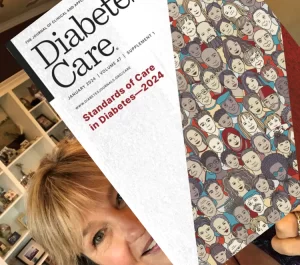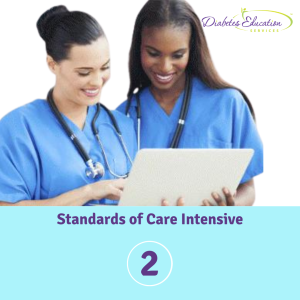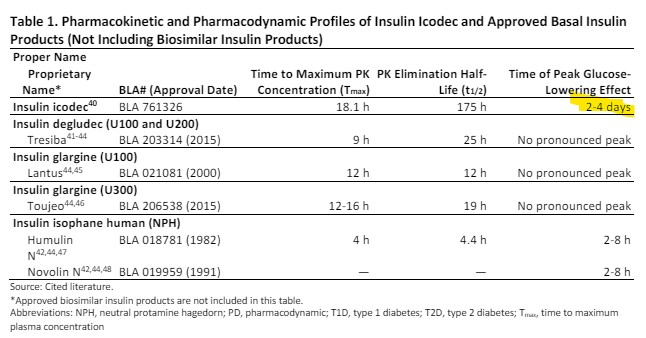
Ready to get certified?
Free CDCES Coach App

Subscribe
eNewsletter
Download
Free Med Pocket Cards
2 Standards CE Courses Needed for CDCES Renewal

It’s been five year since you passed your exam. Now you are approaching your renewal date, so how do you maintain this hard-earned certification? To help you stay on top of this important process, we’ve gathered some essential updates from the CBDCE website.
This year, the CBDCE published new rules to renew certification which you might have missed. To make sure there are no surprises during your renewal process, here are key considerations from the CBDCE Website that we hope you find helpful!
2025 CDCES Renewal Updates
To promote quality and inclusive diabetes care and education, the CBDCE Board changed the continuing education (CE) content requirements. Certificants will still need to complete 75 CE units over a five year period. However, to make sure CDCES’s stay abreast of the latest standards and promote inclusive care, the Board is now requiring participation in CE courses that provide updates on the ADA Standards of Care at least twice during the individual’s renewal cycle.
- Required CE Activities now include ADA Standards Update
This means that starting in 2024, certificants will need to start acquiring these more specific CEs in preparation for 2025 renewal.
According to the CBDCE, to successfully renew their CDCES, applicants must participate in CE activities that are focused on the American Diabetes Association’s Standards of Care for Diabetes* two separate times during your renewal cycle.
- In addition, the following CE Activities are encouraged:
If you are renewing your CDCES in 2025 or later by completing 75 CE units over the five-year period, the CBDCE requires that you demonstrate completion of the following type of CE Activities (you can immediately start accumulating these needed CEs). The CBDCE encourages the following CE activities at least once during your renewal cycle:
- education principals/teaching strategies
- diabetes-related technology;
- leadership/strategy (e.g., CQI, change agent, program development);
- population health; or
- diversity, equity, inclusion, and accessibility (e.g., social determinants of health, cultural competency).
Diabetes Education Services Online University is Here to Help!
*Since Diabetes Education Services is Accredited by the Commission on Dietetic Registration (CDR), all of our courses can be applied toward your CDCES Renewal.
Our content incorporates the ADA Standards and Content Requirement
The bundles listed below are well-suited for meeting CDCES renewal requirements. Additionally, we refresh our entire content library every year to stay current with the latest ADA Guidelines.
In addition, our DiabetesEd Training Programs cover the ADA Standards of Care with clarity and intention by a trio of experts, including Diana Issacs, PharmD, BC-ADM, CDCES, and FADCES a contributing author to the ADA Standards.
Plus, all of our content incorporates education principles and teaching strategies, with a special emphasis on population health, equity, diversity, and inclusion.
We are here to help you succeed. Whether you are starting your journey or working toward recertification, our ADA Standards of Care CE Course, Standards of Care Intensive, CDCES Basic Prep Bundle, and our new “Certification Renewal Bundle” or DiabetesEd Training Conferences are perfect options to meet your goals.
The use of DES products does not guarantee the successful passage of the diabetes certification exams. CBDCE & ADCES does not endorse any preparatory or review materials for the certification exams, except for those published by CBDCE & ADCES.
**To satisfy the requirement for renewal of certification by continuing education for the Certification Board for Diabetes Care & Education (CBDCE), continuing education activities must be applicable to diabetes and approved by a provider on the CBDCE List of Recognized Providers (www.ncbde.org). CBDCE does not approve of continuing education. Diabetes Education Services is accredited/approved by the Commission of Dietetic Registration which is on the list of CBDCE Recognized Providers.
Here's how you can get started right away. Enroll in our ADA Standards of Care Course today!
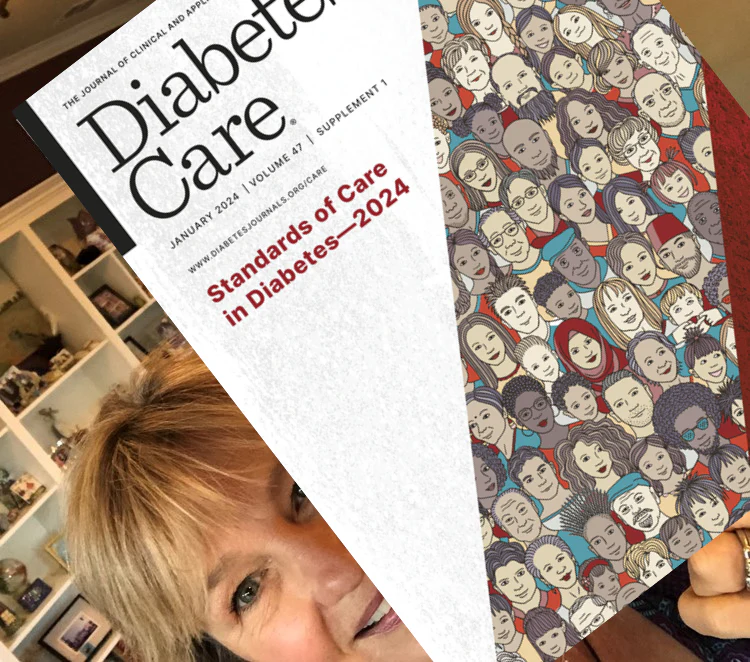
Diabetes Education Services Online University Courses are an excellent way to study for your exam anytime and anywhere that is convenient for you. You will have immediate access to your courses for 1 year after your purchase date. Each online course includes a: video presentation, podcast, practice test, and additional resources.
This course, updated annually, is an essential review for anyone in the field of diabetes. Join Coach Beverly as she summarizes the annual updates to the American Diabetes Association’s (ADA) Standard of Medical Care in Diabetes & provides critical teaching points & content for healthcare professionals involved in diabetes care & education.
The use of DES products does not guarantee the successful passage of the diabetes certification exams. CBDCE & ADCES does not endorse any preparatory or review materials for the certification exams, except for those published by CBDCE & ADCES.
**To satisfy the requirement for renewal of certification by continuing education for the Certification Board for Diabetes Care & Education (CBDCE), continuing education activities must be applicable to diabetes and approved by a provider on the CBDCE List of Recognized Providers (www.ncbde.org). CBDCE does not approve of continuing education. Diabetes Education Services is accredited/approved by the Commission of Dietetic Registration which is on the list of CBDCE Recognized Providers.
Med Updates – Generic Victoza & SGLT-2 for Kids

Victoza (liraglutide) – First GLP-1 Available as a Generic
Victoza is now available in generic form at a slightly reduced monthly price of $469.60 for a 2-pack and $704.40 for a three-pack. According to the ADA average wholesale price chart, Victoza typically costs around $1,340 for a month’s supply, which is about a 50% reduction in price.
Victoza (liraglutide injection 1.8 mg) is a once-daily GLP-1 injection approved to treat type 2 diabetes. It lowers A1C by about 1%, along with weight loss and reduced risk of cardiovascular events. See our Medication PocketCards for more info.
Generic Victoza, produced by Teva Pharmaceuticals, is the first GLP-1 RA that has gone generic. Victoza’s patent in the US and Europe expired in late 2023, paving the way for companies like Teva to pursue generic versions. Two other generic Victoza options are being developed with a possible December 2024 release date. Once multiple Victoza generics are on the market, the hope is that competition will further reduce prices for people who would benefit from this medication. Patents for newer GLP-1 medications like Ozempic and Wegovy won’t expire until several years later.
Launching this more cost-effective generic Victoza comes as many people with diabetes struggle to access the more popular GLP-1 medications like semaglutide (Ozempic) and dulaglutide (Trulicity). Liraglutide (Victoza) was also approved for weight loss for those without diabetes who met the BMI criteria in 2014 under the brand name Saxenda.
The first generic GLP-1 is a significant milestone in improving access to diabetes drugs. With the launch of additional Victoza generics in 2025 and beyond, prices should continue to fall even further, helping more people access these crucial medications.
Another SGLT-2 Approved for Pediatrics
This month, the FDA approved another SGLT-2i, dapagliflozin (Farxiga), for children under the age of 18. Dapagliflozin and empagliflozin are now both approved for pediatrics starting at the age of 10 diagnosed with type 2 diabetes as an adjunct to diet and exercise to improve glycemic control.
The incidence and prevalence of type 2 diabetes in children and adolescents are increasing globally. In the US, there are nearly 30,000 individuals under the age of 20 living with type 2 diabetes, with 5,300 new cases diagnosed each year, according to the US Centers for Disease Control and Prevention and recent research. Children with type 2 diabetes often experience earlier onset of complications than adults and benefit from interdisciplinary care and social support.
Data from the T2NOW Phase III trial, published in The New England Journal of Medicine Evidence, Farxiga, provided clinically meaningful improvements in glycemia for children and adolescents with type 2 diabetes. The safety results in this pediatric population were consistent with those in adults with T2D. Of course, it is essential to provide education on preventing genital infections and any signs of diabetes ketoacidosis. See our Medication PocketCards
The use of DES products does not guarantee the successful passage of the certification exam. CBDCE and ADCES do not endorse any preparatory or review materials for the CDCES or BC-ADM exams, except for those published by CBDCE & ADCES.
Get Ready – How to Prepare for Natural Disasters

As we enter fire and storm season, it’s always a good idea to think ahead and be prepared for disaster. For people living with diabetes, a “diabetes kit” is an important part of emergency preparedness. We are excited to share a few getting ready checklists and resources that we think are really helpful.
For any emergency scenario, it’s important to have an emergency preparedness plan that includes a meeting point, an exit route, a “get-away” bag, and communication strategies. Identify and inform the people who will be included in the emergency plan ahead of time and make sure everyone clearly knows what to do and what action to take.
An easy way to get started is to download the Checklist and Plan created by the Diabetes Disaster Response Coalition. We have also created a Disaster Checklist Word document that you can download and customize for yourselves. These checklists can help you start the conversation and commit the details to paper.
Disaster can happen in a moments notice. It’s important to plan ahead and be ready, especially for people living with diabetes.
Here are a few helpful resources for ourselves and our community:
Resources for People with Diabetes
General information from the Diabetes Disaster Response Coalition (DDRC) on preparedness for people living with diabetes.
Have an Emergency Diabetes Plan and Kit Ready: DDRC’s Diabetes Plan and Kit checklist includes helpful steps to take in preparation for disaster. The checklist details needed supplies and information that should be written down and kept in a waterproof container for emergency situations where is can be found by a health care provider to make informed emergency treatment decisions.
Stay Updated: Visit Breakthrough Type 1 Disaster Relief Resources and Diabetes Disaster Response Coalition includes information on how to access medical support, shelters, and open pharmacies during times of disaster.
Individuals with diabetes who need help: Call 1-800-DIABETES (800-342-2383). The American Diabetes Association Center For Information is open, MON.-FRI. 9 a.m. TO 7 p.m. ET. Representatives are regularly updated with information on how to access medical support, shelters, pharmacies, and more.
American Red Cross Shelters: Contact the American Red Cross directly at 1-800-RED-CROSS.
Resource For Health Care Providers:
- Insulin Supply Hotline: During a disaster, call the emergency diabetes supply hotline 314-INSULIN (314-467-8546) if you know of diabetes supply shortages in your community (i.e. shelter, community center). The hotline is for health care providers only.
- Diabetes Disaster Response Coalition (DRRC). If a disaster hits, people with diabetes may need emergency supplies and help fast. Please visit the DRRC website if you are a diabetes health care provider and are requesting information about diabetes supplies during disasters.
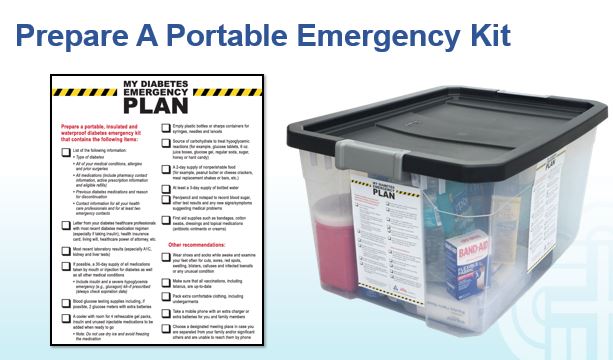
In addition to the items listed below, make sure to pack hand sanitizer, wipes, and masks due to the current pandemic. Also, bring your own pillow and bedding in case you need to spend time in a shelter.
Download, Share, and Personalize this Emergency Checklist
Emergency Evacuation-Items to Gather for People with Diabetes
We thought this list was a helpful way to prioritize what items to grab given different time frame limitations. We found it online and customized it for people with diabetes. It is available in Word or PDF. Thank you for sharing with your colleagues and community.
- Emergency List that you can Customize in a Word Doc
- Emergency List as a PDF to print out
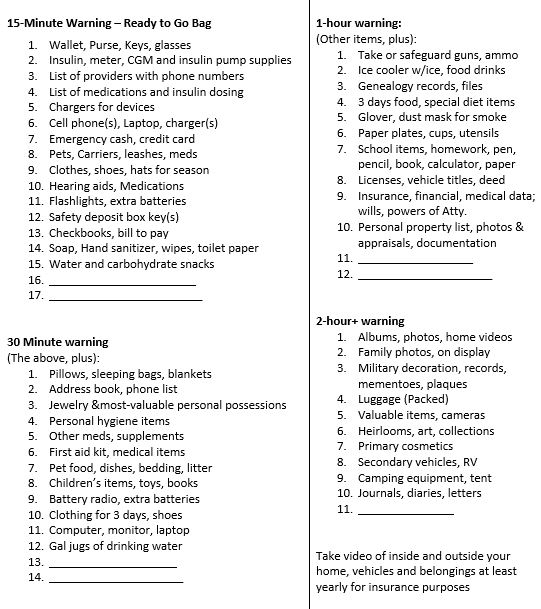
- Emergency List that you can Customize in a Word Doc
- Emergency List as a PDF to print out
1-800-DIABETES (800-342-2383) is an excellent referral resource for people with diabetes to call toll-free for updates on accessing medical support during an emergency.
Sign up for Diabetes Blog Bytes – we post one daily Blog Byte from Monday to Friday. And of course, Tuesday is our Question of the Week. It’s Informative and FREE! Sign up below!
The use of DES products does not guarantee the successful passage of the CDCES exam. CBDCE does not endorse any preparatory or review materials for the CDCES exam, except for those published by CBDCE.
Keeping Cool in the Heat – Tips for People with Diabetes
Hotter Temperatures Worsen Diabetes Outcomes
Increasing global temperatures are expected to impact the health of people living with diabetes and lead to worse outcomes, according to an article published in the Journal of Community Hospital Internal Medicine Perspectives,

People with diabetes are at greater risk of experiencing dehydration and cardiovascular events during periods of extreme heat. Several studies reveal that people with diabetes are more likely to need emergency care during heat waves and those with a history of heart disease are most vulnerable.
Heatwaves can pose increased health risks for people with diabetes due to several factors:
- Increased Cardiovascular Strain: People with diabetes already have a higher risk of cardiovascular issues. The stress of heat waves and high temperatures can further strain the cardiovascular system, increasing the risk of heart-related complications.
- Heat Stress: Heat waves can cause heat stress, especially in individuals with diabetes who may have autonomic neuropathy. Autonomic neuropathy affects the body’s ability to regulate temperature, making it more challenging to adapt to hot weather.
- Dehydration: High temperatures can lead to excessive sweating and fluid loss, increasing the risk of dehydration. Dehydration can affect blood glucose levels and can be associated with hyperglycemia. It can also make it more challenging to manage diabetes effectively.
- Medication Storage: Extreme heat can impact the effectiveness of insulin. Storing insulin at temperatures outside the recommended range can lead to reduced potency, making it less effective in managing blood sugar levels.
- Protect Insulin Pumps and Glucose Meters: If you use an insulin pump or glucose meter, make sure to keep them out of direct sunlight and heat. High temperatures can affect their accuracy and performance.
To keep healthy and reduce risk during heatwaves, we have put a list together of actions people with diabetes can take to stay safe in the heat.
Actions that help people with diabetes stay safe during extreme heat.
Download PDF Handout of 19 Actions Here

- Stay Hydrated: The heat can lead to increased fluid loss through sweating. Dehydration can affect blood sugar levels, so it’s crucial to drink plenty of water throughout the day. Avoid sugary drinks and opt for water or sugar-free beverages.
- Choose the Right Time for Physical Activity: If engaging in outdoor activities, try to do so during cooler parts of the day, such as early morning or late evening. Heat can affect energy levels and might lead to fluctuations in blood sugar levels.
- Wear Proper Footwear: Pavement and walkways can exceed 150 degrees and walking barefoot can lead to serious burns. Always wear shoes. Also, be aware that hot weather can cause feet to swell. Wear comfortable, well-fitting shoes and socks helps to prevent blisters and potential foot injuries.
- Dress Lightly: Wear light, breathable clothing that allows your skin to stay cool and sweat to evaporate. Loose-fitting, moisture-wicking fabrics are ideal for hot weather.
- Use Sunscreen and hats: Protect your skin from sunburn with sunscreen, long sleeves, pants, and hats. Also don’t forget shoes to prevent sunburned feet.
- Be Prepared for Emergencies: Always carry a form of medical identification that indicates you have diabetes, along with emergency contact information. If away from home, inform companions about your condition and what to do in case of an emergency.
- Seek Shade and Take Breaks: When spending time outdoors, find shaded areas and take frequent breaks to rest and cool down. Avoid direct exposure to the sun, especially during peak heat hours (typically 10 am to 4 pm).
- Plan Meals Mindfully: Eat light, refreshing meals that require minimal cooking. Fresh fruits, vegetables, and salads are excellent options during hot weather.
- Use Fans and Air Conditioning: If possible, stay in air-conditioned or well-ventilated spaces. Electric fans can also help circulate air and make you feel cooler.
- Close Curtains and Blinds: Keep curtains and blinds closed during the hottest parts of the day to block out direct sunlight and reduce indoor temperatures.
- Take Cool Showers or Baths: A cool shower or bath can help lower your body temperature and provide temporary relief from the heat.
- Use Cooling Products: Consider using cooling towels, vests, or gel packs to help lower body temperature. Use Wet Cloths or Ice Packs: Apply a cold, damp cloth to the forehead, neck, and wrists. Ice packs in these areas can also help cool down.
- Create Cross-Ventilation: Open windows on opposite sides of your home to create a cross-breeze, allowing cooler air to flow through.
- Stay Informed: Keep an eye on weather forecasts and heat advisories. Stay informed about the temperature and be prepared for extreme heat.
- Limit the Use of Heat-Producing Appliances: Avoid using heat-producing appliances like ovens and stoves during the hottest parts of the day. Opt for microwave cooking or cold meals instead.
- Avoid Hot Cars: Steering wheels, seat covers, and seatbelts can become very hot. Check first before touching. Temperatures inside a car can rise rapidly and become life-threatening.
- Check on Vulnerable Individuals: Keep an eye on elderly relatives, neighbors, and those with health conditions who may be more susceptible to heat-related issues.
- Communicate with Healthcare Team: It’s essential to take proactive steps to stay cool and prevent heat-related illnesses. If you or someone else experiences symptoms of heat exhaustion or heatstroke (such as dizziness, confusion, rapid pulse, or vomiting), seek medical attention immediately.
- Download PDF Handout of 19 Actions Here and share it with colleagues and individuals with diabetes.
Join us LIVE in San Diego for our DiabetesEd Training Conference
October 9th-11th, 2024
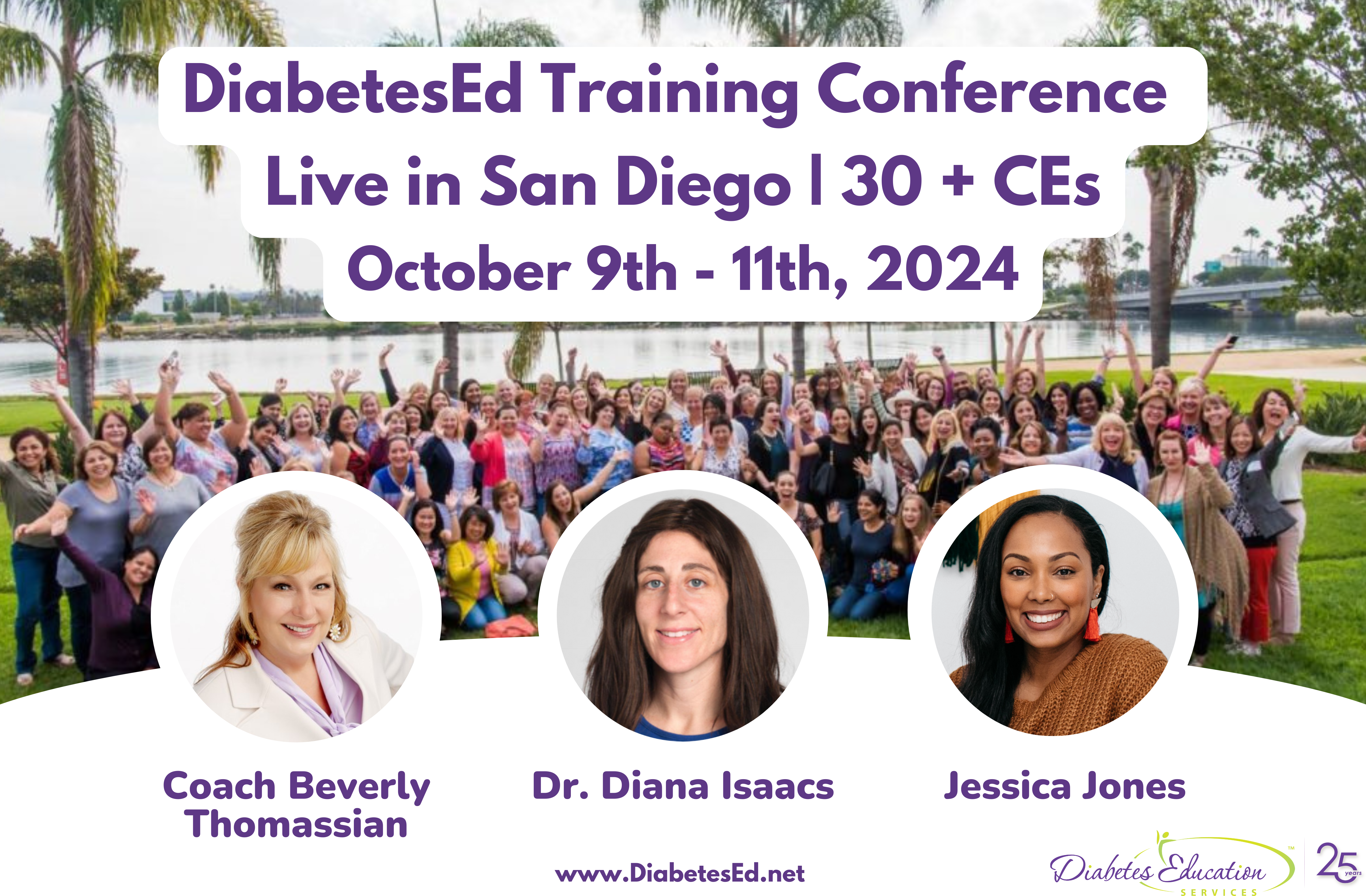
Join Coach Beverly and Team for two and a half days of knowledge-sharing, fun, networking, games with prizes, and “aha” moments in beautiful San Diego on October 9-11, 2024.
You don’t want to miss this one-of-a-kind learning opportunity. Get away from all those daily responsibilities and immerse yourself in a fun and intensive conference with plenty of networking opportunities.
Attendees will leave this conference with new tools and a more complete understanding of the latest advances in diabetes care, from medications to technology to Medical Nutrition Therapy!
Each day, we provide a healthy breakfast, including fresh coffee, to kick off your morning. Our instructors co-teach the content to keep things fresh and lively. Plus, we play DiaBingo to reinforce key content. In addition, we provide plenty of movement breaks led by volunteers from the audience. Did we mention delicious lunches and a conference meeting space just minutes from San Diego Bay?
Friend Discount: 3 or more only $559-$799 (based on registration package) per person. Email us at [email protected] with the name and email of each registrant to get the discount!
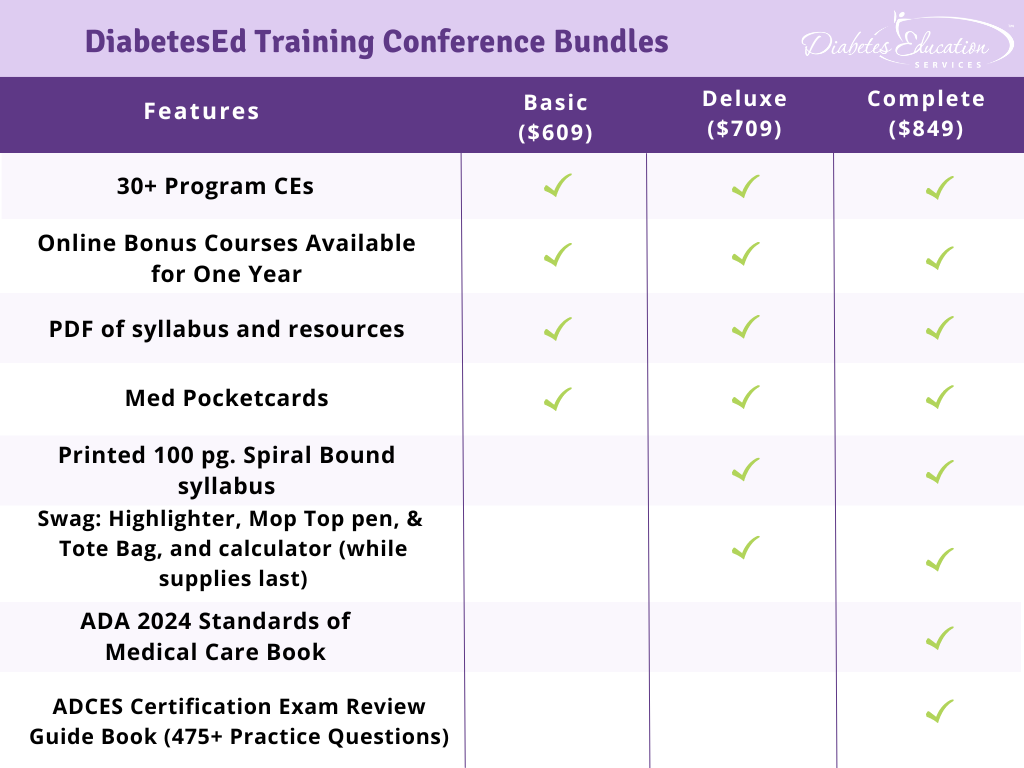
Time: The course is Wednesday through Friday. Join us for breakfast at 7:00 a.m. each day. The class begins at 8:00 a.m. and ends at 5:00 p.m. on Wednesday and Thursday and at 3:00 p.m. on Friday.
- 3 Days: of critical information delivered by passionate speakers in an engaging and fun format!
- 18+ CEs: earned at the Live Seminar (RDs earn 18.75 CEs while Nurses & CA Pharmacists earn 22.75 CEs)
- 10 Bonus Online Courses, Earn 10+ CEs: As a course attendee, you automatically receive a bonus online course bundle of 13 online courses valued at over $179. Coach Beverly carefully chose each of these courses based on student feedback on which content best helped them succeed at the certification exams and in their clinical practice. You will be given instructions after you purchase the course on how to enroll in our Online University and get started!
- Healthy breakfast all days, gourmet lunch both days and refreshments.
- E-version of the syllabus
Sign up for Diabetes Blog Bytes – we post weekly Blog Bytes that are informative and FREE! Every week we post one exam practice Question of the Week and Rationale of the Week. Sign up below!
The use of DES products does not guarantee the successful passage of the certification exam. CBDCE and ADCES do not endorse any preparatory or review materials for the CDCES or BC-ADM exams, except for those published by CBDCE & ADCES.
Once Weekly Insulin Not FDA Approved due to Safety Issues
 Once weekly basal insulin, icodec, failed to be approved for use by people with type 1 diabetes by the FDA’s Endocrinologic and Metabolic Drugs Advisory Committee by a vote of 7-4. The significantly increased risk for hypoglycemia on days two through four after administration outweighed its potential benefits. The committee also noted that icodec’s risk of hypoglycemia is higher than the basal insulin degludec, which is commonly used and has a better safety profile. Other committee members expressed concerns that approving icodec based on inadequate data could discourage further trials that are needed to ensure its safe use.
Once weekly basal insulin, icodec, failed to be approved for use by people with type 1 diabetes by the FDA’s Endocrinologic and Metabolic Drugs Advisory Committee by a vote of 7-4. The significantly increased risk for hypoglycemia on days two through four after administration outweighed its potential benefits. The committee also noted that icodec’s risk of hypoglycemia is higher than the basal insulin degludec, which is commonly used and has a better safety profile. Other committee members expressed concerns that approving icodec based on inadequate data could discourage further trials that are needed to ensure its safe use.
In an effort to secure approval, the applicants for icodec suggested the following actions to improve the safety profile of this novel weekly insulin.
Proposed mitigating actions to reduce hypoglycemia risk by the applicant included;
- icodec only be used for people using a CGM
- individuals with hypoglycemia unawareness would not be candidates for this once weekly insulin
- labeling alternative insulin dose titration strategies to reduce the risk of hypoglycemia (e.g., reducing the bolus insulin dose by approximately 30% between days 2 to 4 after each weekly insulin icodec injection).
- Indicating insulin icodec only for patients with a low % coefficient of variation (%CV) since the subgroup of patients with low glycemic variability, as defined as percent coefficient of variation (%CV<36%), had hypoglycemia risk comparable to the entire cohort of patients on insulin degludec (i.e.,with any %CV).
- Recommending that individuals who experience recurrent hypoglycemia switch to other insulin treatment options
- Providing prescriber and patient training materials to help maximize benefit-risk.
Even though mitigating actions were suggested to decrease this hypoglycemia risk during this two day peak, the FDA panel members still deferred approval, citing safety concerns due to the significant hypoglycemia risk and need for more data..
How would people living with type 1 diabetes benefit from once weekly insulin?
Surprisingly, about one third of people living with type 1 diabetes are still managing blood sugars with multiple daily injections. This is especially true for people living in under resourced communities and people of color living with type 1 diabetes. Due to barriers and social determinants of health, in addition to struggling with multiple daily injections, they are also less likely to use continuous glucose monitors or check blood sugars on a regular basis. Although, once a week insulin seems ideal for individuals who may be experiencing a variety of barriers to injecting daily insulin, the main issue is the increased risk of hypoglycemia during days 2-4 when icodec is peaking coupled with limited access to glucose monitoring.
In addition, consistent injected insulin therapy in adults with type 1 diabetes was reported to be relatively low (52.6%, 95% confidence interval[CI]: 37.4 to 67.9%) in data from a meta-analysis of eight clinical trials. The probability of missing at least one daily basal insulin dose over any 14-day period is estimated to be 22% (95% CI: 10 to 40%).
Among individuals with type 2 diabetes, using a daily basal insulin, a once weekly basal insulin would reduce the number of insulin injections from 365 per year to 52 per year. In a recent study, 91% of people with type 2 diabetes and 89% of providers had a positive view of taking basal insulin once weekly.
Among individuals with type 1 diabetes, who rely on a basal bolus regimen, a once weekly basal insulin would reduce the number of insulin injections from approximately 28 per week to 22 per week. For those with type 1 diabetes, there is no research to date that evaluates whether a once weekly basal insulin would be preferred over other basal insulin options, or whether use would result in improved adherence and glycemic control.
ONWARDS 6 Study Results – Using icodec for people living with Type 1
In ONWARDS 6, weekly insulin icodec was noninferior (but not superior) to daily insulin degludec and was associated with 48 to 89% more level two and three hypoglycemia at Week 26, depending on the method of analysis. The highest risk period for hypoglycemia with insulin icodec coincides with its peak glucose-lowering effect which occurs on days 2 to 4 following each weekly injection. There were also more hypoglycemia-related serious adverse events reported among patients randomized to insulin icodec compared to insulin degludec.
Thus, in the only study conducted in participants with type 1 diabetes, insulin icodec was observed to have a higher risk of clinically meaningful hypoglycemia, in the absence of a lower A1C. Hypoglycemic episodes reported with insulin icodec and insulin degludec in ONWARDS 6 were of the same nature in terms of duration, management, and recovery.
What is Insulin icodec?
Insulin icodec is an acylated long-acting human insulin analog produced by a process that includes expression of recombinant DNA in yeast (Saccharomyces cerevisiae), followed by chemical modification. In addition to amino acid sequencing changes, a C20 fatty-acid side chain has been added to the peptide backbone via the amino group in the side chain at Lys(B29). When insulin icodec is injected, the C20 fatty acid sidechain derivative binds strongly, but reversibly, to endogenous albumin, which results in decreased renal clearance and protection from metabolic degradation, and consequently prolonged pharmacodynamic activity.
Insulin icodec is a proposed insulin analog with a prolonged duration of action intended to support once weekly (QW) subcutaneous administration. Thus, insulin icodec reduces treatment burden in type 1 diabetes, by reducing the number of basal insulin injections in comparison to daily basal insulins.
However,basal insulin icodec does not have a peakless time-action profile throughout the dosing interval (see chart below).
In conclusion, it seems certain that the manufacturers of insulin icodec will be seeking approval for this once weekly insulin for people living with type 1 and type 2 diabetes in the future. Stay tuned for more insulin updates with our monthly newsletter.
Information from this article was obtained from review of the FDA Presentation Document and Slides, May 24, 2024.
Accreditation: The Diabetes Educator Live Course is approved for 26 Contact Hours for nurses and CA Pharmacists and 21 CPE, Level III for RDs. Provider is approved by the California Board of Registered Nursing, Provider # 12640 and Commission on Dietetic Registration (CDR), Provider # DI002. Need hours for your CDCES? We have great news. This program is accredited by the CDR so all hours of instruction can be used to renew your CDCES regardless of your profession. **
The use of DES products does not guarantee the successful passage of the diabetes certification exams. CBDCE & ADCES does not endorse any preparatory or review materials for the certification exams, except for those published by CBDCE & ADCES.
**To satisfy the requirement for renewal of certification by continuing education for the Certification Board for Diabetes Care & Education (CBDCE), continuing education activities must be applicable to diabetes and approved by a provider on the CBDCE List of Recognized Providers (www.cbdce.org). CBDCE does not approve continuing education. Diabetes Education Services is accredited/approved by the Commission of Dietetic Registration which is on the list of CBDCE Recognized Providers.
Food Insecurity and Food Programs
by Christine Craig, MS, RD, CDCES
LT shared during a recent visit that over the past year, money to purchase food has become tight, and there are times when, by the end of the month, they do not have the resources to purchase more food.
In the US, 12.8% of individuals, 17 million households, and 16% of individuals with diabetes report experiencing food insecurity.1
From 2021 to 2022, the prevalence significantly increased by 2.6% within the US population. Food insecurity has racial inequities and has a higher incidence in American or Alaska Native, Black, Hispanic, or multiracial households.1 Children, older adults, individuals with increased diabetes complications, and individuals living in rural and urban areas are among the highest sub-populations at risk.

Food Insecurity Linked to Diabetes
Food insecurity is defined as “the limited or uncertain availability of nutritionally adequate and safe foods or the inability to acquire foods in socially accepted ways.”2 Food insecurity and diabetes have a bi-directional relationship. Insecurity can lead to poor health, and poor health can reduce food access through loss of work/time at work, increased cost of medical care, and increased burden of disease.
Dietary intake and food access is strongly linked to health outcomes, and adults who experience food insecurity are two to three times more likely to develop type 2 diabetes.3 Reduced consumption of fruits, vegetables, and nutrient-dense foods increases the risk of insulin resistance and type 2 diabetes. For low-income individuals, studies3 have shown increased hospital ER visits and admissions for hypoglycemia during the last week of the month compared to earlier weeks. Financial constraints often force individuals to choose between purchasing medications and buying food.
The co-occurrence of diabetes and food insecurity is influenced by nutritional, mental health, and behavioral factors, according to the Weiser et al.2 conceptual framework. At the individual level, interventions targeting food security and diabetes should focus on these interconnected pathways, especially considering the impact of competing demands on self-care prioritization. People living with diabetes and food insecurity often experience increased diabetes distress, depression, and higher A1c levels. Additional challenges such as cost-of-living, transportation, and medication costs further exacerbate these outcomes. Addressing behavioral barriers may involve providing transportation assistance, social work case management, and comprehensive medical care, and ensuring a review of medication costs. Mental health interventions could involve integrating food access programs with mental health screening and referral services in addition to problem-solving and coping strategies to reduce diabetes distress. The most helpful nutrition interventions aim to improve food accessibility, offer person-centered and budget-friendly nutrition counseling, and address policies and programs that reduce diabetes risk and complications.
Food Is Medicine Programs – Medically Tailored Meals
In 2023, the Department of Health and Human Services (HHS) developed the Food Is Medicine initiative, understanding that “access to nutritious food is critical to health and resilience.”3 The initiative focuses on developing strategies to reduce nutrition-related chronic disease and food insecurity while improving health and racial equity in the US.3 Food is Medicine can encompass many different programs, such as medically tailored meals, groceries, or produce prescription programs. Although A1C reduction results are mixed, each of these programs has shown an increase in fruit and vegetable consumption, food security, and quality of life measures.4
For individuals with diabetes, medically tailored meals result in the most evidence for improved diet quality, increased food security, improved diabetes self-management, and reduced hypoglycemic events.4 The programs are associated with lower health care utilization and cost for individuals with complex care needs. Medically tailored meals are designed by an RDN to meet the needs of the individual, are delivered directly to the home, and maybe a covered benefit if medical criteria are met. Seniors may access medically tailored and delivered programs through Medicare Advantage, Medicaid, or Area on Aging programs. Individuals who have chronic conditions and are post-hospital discharge have the highest likelihood of coverage. In California, Medi-Cal may provide up to three meals per day for twelve weeks for individuals with chronic health conditions (such as diabetes) who were recently discharged from a hospital or nursing home or require extensive care coordination. The Food is Medicine Coalition is a resource for additional information regarding Food is Medicine programs and can link individuals and providers to local participating agencies.
Food Insecurity on the Rise
Interventions begin with screening and knowing that more individuals with diabetes will experience food insecurity compared to just one year ago. We can utilize risk assessment tools, including the hunger vital signs, at least annually during our visits and, with patient collaboration, provide referrals to assistance programs. The most extensive federal food assistance programs include the Supplemental Nutrition Assistance Program (SNAP) and the Special Supplemental Nutrition Program for Women, Infants, and Children (WIC). These programs are effective in increasing food security while also improving health outcomes. Reviewing eligibility and assisting in the coordination of services for Food Is Medicine programs, Nutrition Assistance Programs, and resources such as local food pantries, Meals on Wheels, or Area on Aging Agencies programs. www.Findhelp.org is a tool that can help individuals and providers find free or reduced- resources, from food to housing and more. Through assessment, understanding patient priority needs, and linking to resources, we can create a more supportive and therapeutic environment for individuals managing diabetes while experiencing food insecurity.
Links to Listed Resources:
- Food is Medicine Coalition: https://fimcoalition.org
- Hunger Vital Sign: https://fimcoalition.org
- Supplemental Nutrition Assistance Program (SNAP): https://www.fns.usda.gov/snap/supplemental-nutrition-assistance-program
- WIC: https://www.fns.usda.gov/wic
- Local Food Pantries: https://www.feedingamerica.org/our-work/nutrition-health
- Meals on Wheels: https://www.mealsonwheelsamerica.org/find-meals
- Area on Aging Agencies: https://eldercare.acl.gov/Public/About/Aging_Network/AAA.aspx
- Find Help: www.findhelp.org
References:
- Food Security and Nutrition Assistance downloaded on June 19th, 2024 from: https://www.ers.usda.gov/data-products/ag-and-food-statistics-charting-the-essentials/food-security-and-nutrition-assistance/#:~:text=In%202022%2C%2012.8%20percent%20of,of%20a%20lack%20of%20resources
- Weiser, Sheri & Palar, Kartika & Hatcher, Abigail & Young, Sera & Frongillo, Edward & Laraia, Barbara. (2015). Food Insecurity and Health: A Conceptual Framework. 10.1201/b18451-3.
- Food is Medicine: A Project to Unify and Advance Collective Action. Downloaded on June 19th, 2024 from https://health.gov/our-work/nutrition-physical-activity/food-medicine.
- Levi R, Bleich SN, Seligman HK. Food Insecurity and Diabetes: Overview of Intersections and Potential Dual Solutions. Diabetes Care. 2023 Sep 1;46(9):1599-1608. doi: 10.2337/dci23-0002. PMID: 37354336; PMCID: PMC10465985.
- Wylie-Rosett J, DiMeglio LA. Strategies to Reduce Food Insecurity for People With Diabetes: A Call to Action. Diabetes Care. 2023 Feb 1;46(2):245-248. doi: 10.2337/dci22-0058. PMID: 36701599; PMCID: PMC9887607.
May 2024 eNews | Why don’t CGM readings match meter glucose results? Person-Centered Coaching & Technology; Step-By-Step Approach, Biggest Takeaway when Addressing Diabetes Distress?
Happy May
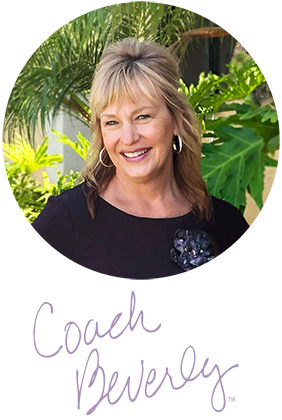
In our rural clinic, we are starting more and more individuals on glucose sensors. People’s response to using a CGM device has garnered mixed reactions. Most individuals are thrilled that they can see their blood sugars are at a glance with fewer finger pricks. They feel empowered with this play-by-play blood sugar report.
However, others experience a sense of overwhelm in response to the sudden onslaught of glucose data on their screen. This stress becomes more acute as they hone in on sugar spikes or sudden lows that don’t seem to have a rhyme or reason. In addition, many people are confused by the discrepancy between the meter and sensor glucose, causing even more upset.
These individuals may experience an understandable amount of confusion, frustration, and distress.
This newsletter provides a range of tools and resources to assist you in addressing these distress points, detailed in the following featured articles.
Our first article explores the reasons behind the gap between CGM and meter readings. We also provide a CGM Troubleshooting Cheat Sheet that you can share with your colleagues and clients.
Next, we outline a step-by-step communication approach designed to help individuals adjust to sensor data overwhelm using a person-centered approach.
Finally, we address diabetes distress by interviewing expert Susan Guzman, PhD. You are invited to join Dr. Guzman and Larry Fisher, PhD, who will share their expertise on this topic in June, during our highly popular ReVive 5 training program.
Our last article recognizes the healing relationship we have with our pets. Challenge yourself with our Question and Rationale of the Week and please keep in touch.
Sending notes of joy and health, Coach Beverly, Bryanna, and Christine |
Featured Articles
Upcoming Webinars
- Older Adults and Diabetes Disease – May 2nd
- Prep for CDCES – May 28
- ReVive 5 – June 17th & 24th
- Upcoming Events – See the complete calendar listing
Want to learn more about this question?
Unlock insights for managing diabetes distress with the experts!
Join us live on June 17 & 24, 2024 for our
ReVive 5 Diabetes Training Program:
The 2024 ADA Standards of Care now recommends annual screening for diabetes distress. If you are wondering how to screen for distress and tailor education based on the results, we encourage you to join this unique training program.
This two-session training provides the essential steps to address diabetes distress combined with an innovative approach to helping people make sense of their glucose data.
The first session is team-taught by experts in the field of diabetes distress and effective communication approaches. Dr. Larry Fisher kicks off the program by describing the difference between depression and distress and interpreting Diabetes Distress screening results. Dr. Susan Guzman uses a case study approach and step-by-step communication strategies to address responses from the Diabetes Distress screening tool. This session includes an abundance of evidence-based approaches that you can apply in your clinical setting.
Coach Beverly leads the second session. During this three-hour program, Beverly describes insulin dosing strategies, meter and sensor data interpretation, and common issues encountered by people using diabetes technology. Case studies include tools to help individuals discover what changes are needed to get glucose to target, coupled with the communication skills discussed in the first session. In conclusion, the team of instructors review a case study that pulls together all the ReVive 5 elements.
“ReVive 5” breathes new life into our relationship with diabetes, bringing a fresh perspective to both the person with diabetes and the provider.
Can’t join live? That’s okay. Your registration guarantees you access to the recorded version of the series, along with podcasts and resources for one full year.
Accredited Training Program:
- 15+ CEs – Includes the 7-hour ReVive 5 Training Program, Certificate, and 5 FREE bonus courses to supplement content.
- A comprehensive set of assessment tools, educational materials, log sheets, and resources.
Join us to gain the confidence and learn the skills needed to support people with diabetes to move forward in their self-management and discover the expert within.
Team of Experts:
ReVive 5 is taught by a team of 3 Interdisciplinary Experts:
- Lawrence Fisher, Ph.D., ABPP, Professor Emeritus, UCSF
- Susan Guzman, PhD
- Beverly Thomassian, RN, MPH, CDCES, BC-ADM
Speakers Interviews – Learn more about the ReVive 5 Team
Sign up for Diabetes Blog Bytes – we post weekly Blog Bytes that are informative and FREE! Every week we post one exam practice Question of the Week and Rationale of the Week. Sign up below!
Accreditation: Diabetes Education Services is an approved provider by the California Board of Registered Nursing, Provider 12640, and our CPEU courses have received Prior Approval* from the Commission of Dietetic Registration (CDR), Provider DI002. Since our CPEU courses received Prior approval* from the CDR, these CPEU courses satisfy the CE requirements for the CDCES /BC-ADM regardless of your profession!
The use of DES products does not guarantee the successful passage of the certification exam. CBDCE and ADCES do not endorse any preparatory or review materials for the CDCES or BC-ADM exams, except for those published by CBDCE & ADCES.
Question of the Week | RD feels overwhelmed by all this sensor data. Best action?

RD is 82 years old, on basal insulin with bolus insulin at breakfast and dinner if need. RD just started using a sensor to track their daily blood sugars. After using the sensor for a few weeks, they share that they are feeling anxious and don’t know what to do with all this information. They even took extra bolus insulin yesterday to try and get blood sugars down. RD’s time in range is over 70%.
Which of the following is the most appropriate intervention?
- Refer RD to a mental health provider who specializes in diabetes.
- Reassure RD that their time is range is on target and they are not at risk of complications.
- Suggest that RD stops using a sensor and resumes using a glucose meter.
- Explore feelings of anxiety associated with the data and glucose levels.
Unlock insights for managing diabetes distress with the experts!
Join us live on June 17 & 24, 2024 for our
ReVive 5 Diabetes Training Program:
The 2024 ADA Standards of Care now recommends annual screening for diabetes distress. If you are wondering how to screen for distress and tailor education based on the results, we encourage you to join this unique training program.
This two-session training provides the essential steps to address diabetes distress combined with an innovative approach to helping people make sense of their glucose data.
The first session is team-taught by experts in the field of diabetes distress and effective communication approaches. Dr. Larry Fisher kicks off the program by describing the difference between depression and distress and interpreting Diabetes Distress screening results. Dr. Susan Guzman uses a case study approach and step-by-step communication strategies to address responses from the Diabetes Distress screening tool. This session includes an abundance of evidence-based approaches that you can apply in your clinical setting.
Coach Beverly leads the second session. During this three-hour program, Beverly describes insulin dosing strategies, meter and sensor data interpretation, and common issues encountered by people using diabetes technology. Case studies include tools to help individuals discover what changes are needed to get glucose to target, coupled with the communication skills discussed in the first session. In conclusion, the team of instructors review a case study that pulls together all the ReVive 5 elements.
“ReVive 5” breathes new life into our relationship with diabetes, bringing a fresh perspective to both the person with diabetes and the provider.
Can’t join live? That’s okay. Your registration guarantees you access to the recorded version of the series, along with podcasts and resources for one full year.
Accredited Training Program:
- 15+ CEs – Includes the 7-hour ReVive 5 Training Program, Certificate, and 5 FREE bonus courses to supplement content.
- A comprehensive set of assessment tools, educational materials, log sheets, and resources.
Team of Experts:
ReVive 5 is taught by a team of 3 Interdisciplinary Experts:
- Lawrence Fisher, Ph.D., ABPP, Professor Emeritus, UCSF
- Susan Guzman, PhD
- Beverly Thomassian, RN, MPH, CDCES, BC-ADM
Speakers Interviews – Learn more about the ReVive 5 Team
Sign up for Diabetes Blog Bytes – we post weekly Blog Bytes that are informative and FREE! Every week we post one exam practice Question of the Week and Rationale of the Week. Sign up below!
Accreditation: Diabetes Education Services is an approved provider by the California Board of Registered Nursing, Provider 12640, and our CPEU courses have received Prior Approval* from the Commission of Dietetic Registration (CDR), Provider DI002. Since our CPEU courses received Prior approval* from the CDR, these CPEU courses satisfy the CE requirements for the CDCES /BC-ADM regardless of your profession!
The use of DES products does not guarantee the successful passage of the certification exam. CBDCE and ADCES do not endorse any preparatory or review materials for the CDCES or BC-ADM exams, except for those published by CBDCE & ADCES.

